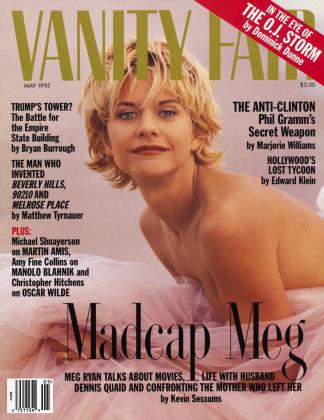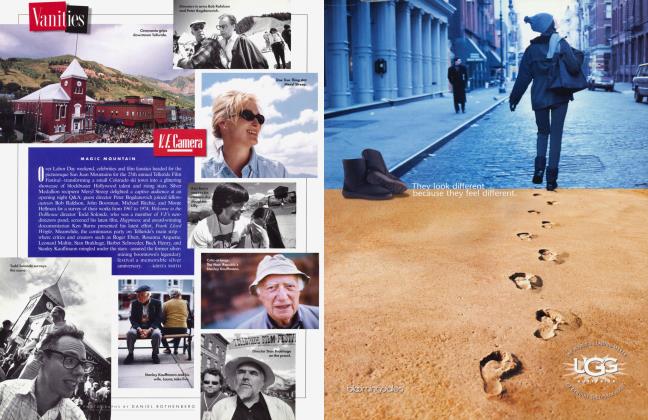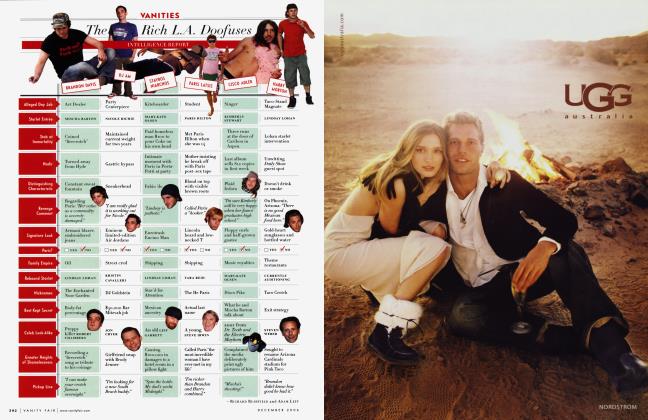Sign In to Your Account
Subscribers have complete access to the archive.
Sign In Not a Subscriber?Join NowHype & Glory
JULIE BURCHILL
The diamonds, the divorces, the drugs, and the drink: the private lives of Elizabeth and excess
The lives of the stars, it seems, continue to fascinate us—the lives of the stars, that is, who stopped making movies before we started watching them. As the biographies of Hepburn, Dietrich, and Monroe continue to haunt the best-seller lists, we are led to wonder whether similar studies of Michelle Pfeiffer and Jennifer Jason Leigh, however incandescent their screen presences, will have the publishers salivating into their scotch some 30 years after the stars have retired from the moving-picture industry.
As befits the woman who owns the alternative crown jewels, shares a first name with Great Britain's reigning monarch, and has the ultimate Hanoverian bosom, Elizabeth Taylor is the natural queen of the "No, but I Read the Book" syndrome: as public disinclination to see her on the screen increases, so does interest in reading about her long, lush life. With at least nine biographies already under the bulging belts of the book trade, two more are about to hit the stores.
In the time-honored tradition of good cop/bad cop, C. David Heymann and Donald Spoto are a pretty good double act. Heymann's Liz (a name she hates, as Mr. Heymann admits gleefully)—out from Birch Lane Press—will doubtless be top dog, boasting the best publicity angle possible: that Miss Taylor busted a gut trying to stop publication. You can see why; it really does contain enough new dirt to keep a colony of cockroaches at Weight Watchers for the rest of their lives. Her father is portrayed as an alcoholic homosexual, her mother as an overbearing stage mother. Far from living the life of a fairy-tale princess, Taylor is painted as a freak from— literally—day one: she was a "strange" baby, ears covered in "black fuzz," and thus "alarmed" her Waspy mother. Heymann seems obsessed with Miss Taylor's body hair (Spoto merely glosses over it), and reveals that she suffered from "hypertrichosis," which had her "arms, shoulders and back covered with a thick downy pelt. The infant looked like a little monkey," as one loyal family friend recalls. The stress on her extraneous hair is so relentless that if this book weren't illustrated one could be forgiven for thinking that the young Elizabeth Taylor, circa A Place in the Sun, bore an uncanny resemblance to Cousin Itt.
And an ugly Cousin Itt, at that. Entertaining though this book is, its central premise is a little . . . off, shall we say. I'm sure we could all be convinced that Liz was "a ballbreaker," "sensual and silly—rather like a heifer in heat," as well as "spoiled, difficult, completely self-absorbed." Girls just want to have fun, after all, and Liz was the only Great American Film Star of the 20th century to emerge as victor rather than victim. What we cannot so easily swallow, and what C. David Heymann is determined to thrust down our throats, is that even in her prime, her Butterfield 8Cat on a Hot Tin Roof prime, Taylor was not physically attractive! That's right; the first casting director to see her said, "This kid has nothing." Though she was hired by Universal at the age of nine, her contract was canceled within a year. At 11 she cleverly grew breasts in 90 days in order to win the role of Velvet Brown, and thank goodness she did, because the rest of her remained, according to Heymann, a right load of rubbish: "she always seemed ordinary to me, cheap-looking"; "small, pudgy hands"; "the worstdressed American actress since Mae West"; "tended to gain weight at every meal"; "she is short and she's got a common accent." No wonder her first husband had to be practically forced to deflower her. Sadly, after calling so many witnesses to swear that the young Elizabeth Taylor was terrifying to look upon, Heymann shoots himself in the foot somewhat by including several photographs which bear out the radical and shocking theory that all through the 1950s and well into the 1960s Elizabeth Taylor was quite simply the most beautiful woman in the world.
(Continued on page 93)
(Continued from page 90)
As well as one of the finest and most underrated screen actresses of her generation, as Donald Spoto reminds us throughout his altogether more civilized book, A Passion for Life: The Biography of Elizabeth Taylor (HarperCollins). It's all there: the I'm Still Here roll call after six decades in the V.I.P. lounge of life, the eight marriages, the divorces, the diamonds, the drugs, the drink, the denunciations from the Vatican, the injuries, the illnesses, and, worst of all, the copious wearing of caftans. Besides being softer on E.T. than Heymann is, Spoto also comes through as the more sophisticated of the two biographers, well aware that Taylor's story is less that of just another 20th-century woman and more that of a natural wonder/natural disaster—Hurricane Liz.
But a place for a force of nature seems unlikely in contemporary, bed-beforerunning-before-7 Hollywood (where in the world would Demi Moore, say, find the time for eight marriages?), where young studs and starlets seem more interested in swapping organic-juice recipes than body fluids on that all-important first date. Once her fuel-injected beauty was used up (somewhere in the 60s) and the good roles stopped being offered to her, it was inevitable that she had to slow down; a hedonist who is neither beautiful nor a star is in severe danger of simply looking like a slob. Logically, selling scent and mothering Michael Jackson are dignified ways for a woman of 63 to spend the sunset (as opposed to the tequila sunrise) of her days.
Selling scent and mothering Michael Jackson are dignified ways for a woman of 63 to spend the sunset of her days.
But then, when was stardom ever about logic? Sterling though her AIDS work is, and (typically of her) obviously far more heartfelt than it is with 99 percent of the Simon Says-ish Little Red-Ribbonheads, and solid though her marriage to Mr. Larry Fortensky seems to be, there is something mildly depressing, if not fullblown tragic, about seeing such a wanton, wayward woman finally grow up and buckle down. She who once towered over the slick skyline of American Sex like King Kong (a comparison at least Mr. Heymann will surely approve of) is now the cosmic clean-up woman for Michael Jackson—holding a squalid little condom in the hands that once carried the weight of the world's most precious gems for the benefit of the world's photographers.
Never mind; as long as the phantom Liz—as soft as a sigh and as sharp as a shiv—stalks the screens of late-night movies in her silky slips, pursuing terrified lover-boys through scenes from the sex war in such movies as Butterfield 8 and Cat on a Hot Tin Roof that superhuman beauty, that otherworldly creature E.T., will live on.
 View Full Issue
View Full Issue












Subscribers have complete access to the archive.
Sign In Not a Subscriber?Join Now